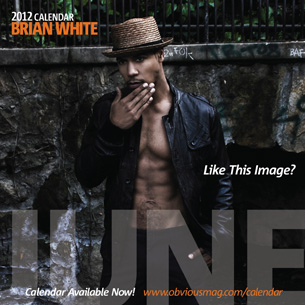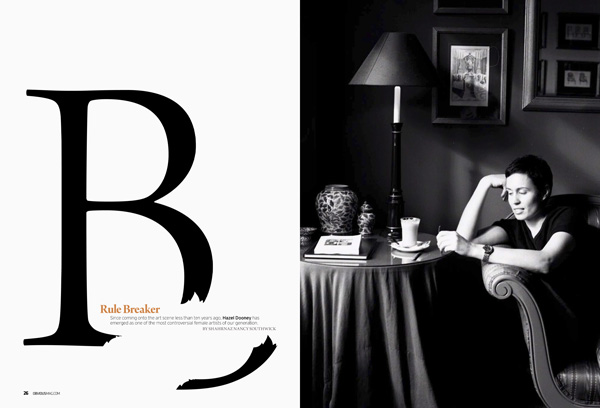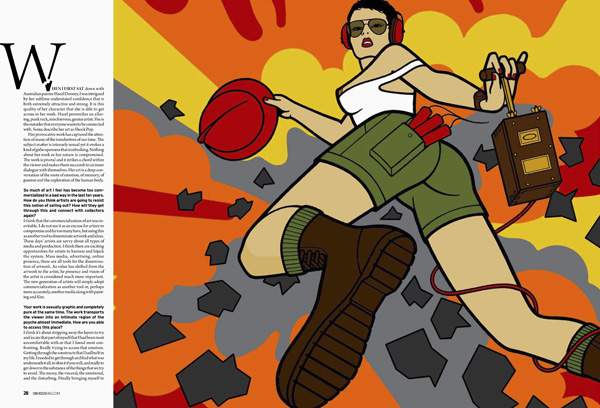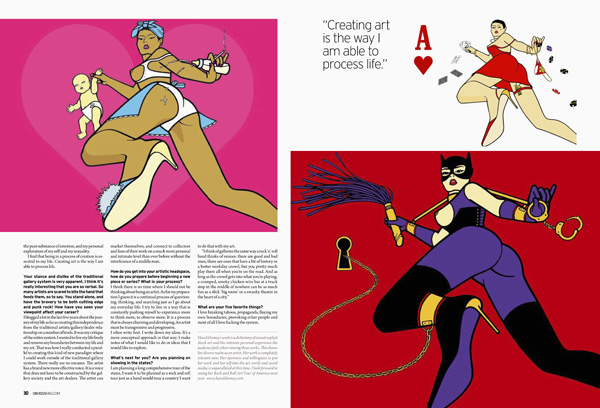Hazel the Rule Breaker
Women Editorials — By ObviousMag on January 14, 2011 6:56 AMWords by Shahrnaz Nancy Southwick.
When I first sat down with Australian painter Hazel Dooney, I was intrigued by her sublime understated confidence that is both extremely attractive and strong. It is this quality of her character that she is able to get across in her work. Hazel personifies an alluring, punk rock, mischievous, genius artist. Since coming onto the art scene less than ten years ago she has emerged as one of the most controversial female artists of our generation. She is the outsider that everyone wants to be connected with. Some describe her art as Shock Pop.
Her provocative work has captured the attention of many of the trendsetters of our time. The subject matter is intensely sexual yet it evokes a kind of girlie openness that is refreshing. Nothing about her work or her nature is compromised. The work is pivotal and it strikes a chord within the viewer and makes them succumb to an inner dialogue with themselves.
Her art is a deep conversation of the roots of emotion, of memory, of passion and the exploration of the human body.
Shahrnaz Nancy Southwick: So much of art I feel has become too commercialized in a bad way in the last ten years. How do you think artists are going to resist this notion of selling out? How will they get through this and connect with collectors again?
Hazel Dooney: I think that the commercialization of art was inevitable. I do not see it as an excuse for artists to compromise and far too many have, but using this as another tool to disseminate artwork and ideas. These days’ artists are savvy about all types of media and production. I think there are exciting opportunities for artists to harness and hijack the system. Mass media, advertising, online presence, these are all tools for the dissemination of artwork. As value has shifted from the artwork to the artist, he presence and vision of the artist is considered much more important. The new generation of artists will simply adopt commercialization as another tool or, perhaps more accurately, another media along with painting and film.
SNS: Your work is sexually graphic and completely pure at the same time. The work transports the viewer into an intimate region of the psyche almost immediate. How are you able to access this place?
HD: I think it’s about stripping away the layers to try and locate that part of myself that I had been most uncomfortable with or that I found most confronting. Really trying to access that emotion. Getting through the constructs that I had built in my life. I needed to get through and find what was underneath it all, to skin it if you will, and really to get down to the substance of the things that we try to avoid. The messy, the visceral, the emotional, and the disturbing. Finally bringing myself to the pure substance of emotion, and my personal exploration of my self and my sexuality. I find that being in a process of creation is essential to my life. Creating art is the way I am able to process life.
SNS: Your stance and dislike of the traditional gallery system is very apparent. I think it’s really interesting that you are so verbal. So many artists are scared to bite the hand that feeds them, so to say. You stand alone, and have the bravery to be both cutting edge and punk rock! How have you seen your viewpoint affect your career?
HD: I blogged a lot in the last five years about the journey of my life as far as creating this independence from the traditional artists/gallery/dealer relationship on a number of levels. It was my critique of the entire system. I wanted to live my life freely and remove any boundaries between my life and my art. That was how I really conducted a parallel to creating this kind of new paradigm where I could work outside of the traditional gallery system.
There really are no excuses. The artist has a brand new more effective voice. It is a voice that does not have to be constructed by the gallery society and the art dealers. The artist can market themselves, and connect to collectors and fans of their work on a much more personal and intimate level than ever before without the interference of a middle man.
SNS: How do you get into your artistic headspace, how do you prepare before beginning a new piece or series? What is your process?
HD: I think there is no time where I should not be thinking about being an artist. As for my preparation I guess it is a continual process of questioning, thinking, and searching just as I go about my everyday life. I try to live in a way that is constantly pushing myself to experience more to think more, to observe more. It is a process that is always churning and developing. An artist must be transgressive and progressive. I often write first. I write down my ideas. It’s a more conceptual approach in that way. I make notes of what I would like to do or ideas that I would like to explore.
SNS: What’s next for you? Are you planning on showing in the states?
HD: I am planning a long comprehensive tour of the states. I want it to be planned as a rock and roll tour just as a band would tour a country I want to do that with my art.
“I think of galleries the same way a rock ‘n’ roll band thinks of venues: there are good and bad ones, there are ones that have a bit of history or a better weekday crowd, but you pretty much play them all when you’re on the road. And as long as the crowd gets into what you’re playing, a cramped, smoky chicken-wire bar at a truck stop in the middle of nowhere can be as much fun as a slick ‘big room’ or a swanky theatre in the heart of a city.”
SNS: What are your five favorite things?
HD: I love breaking taboos, propaganda, flaying my own boundaries, provoking other people and most of all I love fucking the system.
Hazel Dooney’s work is a dichotomy of sexual explicit shock art and the intimate personal experience the audience feels when viewing these works. This shows her diverse realm as an artist. Her work is completely relevant now. Her openness and willingness to put her work and her self into the art world and social media is unparalleled at this time. I look forward to seeing her Rock and Roll Art Tour of America this year.
www.hazeldooney.com
Portrait Photo by Creed C. O’Hanlon













 Tweet This
Tweet This Share on Facebook
Share on Facebook Digg This
Digg This Bookmark
Bookmark Stumble
Stumble
3 Comments
“The new generation of artists will simply adopt commercialization as another tool or, perhaps more accurately, another media along with painting and film.”
Everyone needs to do this, everyone. From the corner grocer, to the systems analyst overseeing a manufacturing process in a factory full of robot assemblers, to open source software developers.
In a global economy, it’s not an option. It’s a necessity. Artists must lead the way.
Being nameless and faceless is a luxury no one can afford.
Hello,
It is rather beautiful to see Pop Art Second generation with a zest of Dolly bird in a Barbie Doll set of outfits. Quite an interresting concept to change the clothing as you desire like with the Barbie you would get your daughters.
I do love her work but the one thing I might regret in a second generation of Pop Art Artist is a loss of sharp edges,loss of the rebelion, there works have been absorbed by the Commercial materialistic Money market the original Pop art movement was critisising in our capitalist & consuming materialistic society. As much as I love the work, and I do, one should not be blinded by some romantic ideas about Artists by the “plebe” I mean us, you.
I do find your article very good and well edited, but an article where we learn nothing more than we already know, quite a pre-written to fit the new guest.
I feel you could have been more sharper and interresting because the artist here is much more interresting that your exposure.
Sorry for being critical but you left me hungry !
yours, Lyllie.
So you do not know about jeff Koone, then you exercised censure when there was only a comment ,polite and simply honest.So in fact you might not be honest, I am sad, I do own a Hazel Dooney, while you don’t.
you are surprising.
So we will meet again,
Lyllie the Bunny